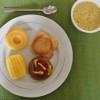 Resources and tools at ChooseMyPlate.gov that provide clear, actionable information about how to make better food choices can be easily adapted for persons with swallowing difficulties (dysphagia) that require texture-modified foods. This 3-page fact sheet was written by Jamila R. Lepore, Nancy Gal, and Wendy J. Dahl, and published by the UF Department of Food Science and Human Nutrition, December 2012.
Resources and tools at ChooseMyPlate.gov that provide clear, actionable information about how to make better food choices can be easily adapted for persons with swallowing difficulties (dysphagia) that require texture-modified foods. This 3-page fact sheet was written by Jamila R. Lepore, Nancy Gal, and Wendy J. Dahl, and published by the UF Department of Food Science and Human Nutrition, December 2012.
http://edis.ifas.ufl.edu/fs207
Author: dihagan
Beyond 'Earlygold': Juice Color and Quality of Additional Early-Maturing Sweet Orange Selections (HS1209)
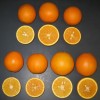 This publication summarizes 5 years of juice quality information about 15 early-maturing sweet orange selections introduced to Florida and evaluated after ‘Earlygold’ became available. The trees were grown at a central Florida and Indian River location for about 10 years. Also presented are observations on tree development summarized across both locations and two rootstocks. This 8-page fact sheet was written by Horticultural Sciences, and published by the UF Department of William S. Castle, January 2013.
This publication summarizes 5 years of juice quality information about 15 early-maturing sweet orange selections introduced to Florida and evaluated after ‘Earlygold’ became available. The trees were grown at a central Florida and Indian River location for about 10 years. Also presented are observations on tree development summarized across both locations and two rootstocks. This 8-page fact sheet was written by Horticultural Sciences, and published by the UF Department of William S. Castle, January 2013.
http://edis.ifas.ufl.edu/hs1209
Sensory Acceptability of Pureed Foods (FSHN1213/FS206)
 It is important that we enjoy the food we eat. This makes for a better quality of life. This is no different for those people needing to be on puréed diets due to swallowing problems. And just like you wouldn’t want to serve guests a recipe without trying it first, you don’t want to serve a puréed food without knowing that it is appealing. This 5-page fact sheet was written by Jamila R. Lepore and Wendy J. Dahl, and published by the UF Department of Food Science and Human Nutrition, November 2012.
It is important that we enjoy the food we eat. This makes for a better quality of life. This is no different for those people needing to be on puréed diets due to swallowing problems. And just like you wouldn’t want to serve guests a recipe without trying it first, you don’t want to serve a puréed food without knowing that it is appealing. This 5-page fact sheet was written by Jamila R. Lepore and Wendy J. Dahl, and published by the UF Department of Food Science and Human Nutrition, November 2012.
http://edis.ifas.ufl.edu/fs206
La aceptabilidad sensorial de los alimentos en pure (FSHN1213S/FS216)
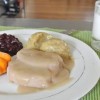 La evaluación sensorial es el proceso en el que utilizamos nuestros sentidos (gusto, olfato, tacto, vista) y su aplicación para la determinación de la aceptabilidad de los alimentos. ¡Simplemente, se están evaluando los alimentos para asegurarse que se ven, huelen y saben delicioso! This 6-page fact sheet was written by Jamila R. Lepore and Wendy J. Dahl, and published by the UF Department of Food Science and Human Nutrition, December 2012.
La evaluación sensorial es el proceso en el que utilizamos nuestros sentidos (gusto, olfato, tacto, vista) y su aplicación para la determinación de la aceptabilidad de los alimentos. ¡Simplemente, se están evaluando los alimentos para asegurarse que se ven, huelen y saben delicioso! This 6-page fact sheet was written by Jamila R. Lepore and Wendy J. Dahl, and published by the UF Department of Food Science and Human Nutrition, December 2012.
http://edis.ifas.ufl.edu/fs216
Women and Money: Unique Issues – Finances in a Divorce (FCS7247/FY1349)
 Separation and divorce impact family financial management on multiple levels. Women going through a divorce will have reduced resources and the added expenses of the divorce process. If you are going through a divorce, you should carefully examine the financial factors listed in this publication. Also, you should know that sensible planning may help to lessen the financial stress associated with the transition from marriage to divorce. This 7-page fact sheet was written by Lynda Spence, Martie Gillen, and Diann Douglas, and published by the UF Department of Family Youth and Community Sciences, January 2013.
Separation and divorce impact family financial management on multiple levels. Women going through a divorce will have reduced resources and the added expenses of the divorce process. If you are going through a divorce, you should carefully examine the financial factors listed in this publication. Also, you should know that sensible planning may help to lessen the financial stress associated with the transition from marriage to divorce. This 7-page fact sheet was written by Lynda Spence, Martie Gillen, and Diann Douglas, and published by the UF Department of Family Youth and Community Sciences, January 2013.
http://edis.ifas.ufl.edu/fy1349
Datos sobre la Tiamina (FCS8667S/FY1342)
 La tiamina es una de las vitaminas del grupo B. Es también llamada B1. Nosotros necesitamos tiamina para utilizar los carbohidratos que comemos. La tiamina ayuda a transformar los carbohidratos en energía para el cuerpo. El cuerpo también necesita tiamina para usar algunos de los aminoácidos que componen las proteínas. This 2-page fact sheet was written by R. Elaine Turner y Wendy J. Dahl, and published by the UF Department of Family Youth and Community Sciences, November 2012.
La tiamina es una de las vitaminas del grupo B. Es también llamada B1. Nosotros necesitamos tiamina para utilizar los carbohidratos que comemos. La tiamina ayuda a transformar los carbohidratos en energía para el cuerpo. El cuerpo también necesita tiamina para usar algunos de los aminoácidos que componen las proteínas. This 2-page fact sheet was written by R. Elaine Turner y Wendy J. Dahl, and published by the UF Department of Family Youth and Community Sciences, November 2012.
http://edis.ifas.ufl.edu/fy1342
Informacion para los propietarios: Cancro Citrico (PP298)
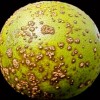 El cancro cítrico es una enfermedad introducida en Florida y es muy perjudicial económicamente para la industria comercial. La enfermedad no está presente en todas las regiones tropicales y subtropicales productoras de cítricos donde el cancro cítrico puede ser problemático, por lo tanto, las restricciones para exportar fruta con cancro cítrico son muy estrictas. Esta enfermedad también concierne a los propietarios, no solo por sus efectos en la industria económica, sino también porque es altamente contagiosa y la mayoría de la fruta contagiada en un árbol muy afectado se cae de éste prematuramente. This 4-page fact sheet was written by M. M. Dewdney, P. D. Roberts, J. H. Graham, K. R. Chung, and M. Zekri, and published by the UF Department of Plant Pathology, January 2013.
El cancro cítrico es una enfermedad introducida en Florida y es muy perjudicial económicamente para la industria comercial. La enfermedad no está presente en todas las regiones tropicales y subtropicales productoras de cítricos donde el cancro cítrico puede ser problemático, por lo tanto, las restricciones para exportar fruta con cancro cítrico son muy estrictas. Esta enfermedad también concierne a los propietarios, no solo por sus efectos en la industria económica, sino también porque es altamente contagiosa y la mayoría de la fruta contagiada en un árbol muy afectado se cae de éste prematuramente. This 4-page fact sheet was written by M. M. Dewdney, P. D. Roberts, J. H. Graham, K. R. Chung, and M. Zekri, and published by the UF Department of Plant Pathology, January 2013.
http://edis.ifas.ufl.edu/pp298
Ornamental Palms for Central Florida (ENH60/EP020)
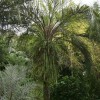 Palms are often thought of as symbols of the tropics, but fortunately there are a number of palm species that grow in warm, temperate climates, such as that of Central Florida. This 8-page fact sheet was written by Timothy K. Broschat and James E. Davis, and published by the UF Department of Environmental Horticulture, January 2013.
Palms are often thought of as symbols of the tropics, but fortunately there are a number of palm species that grow in warm, temperate climates, such as that of Central Florida. This 8-page fact sheet was written by Timothy K. Broschat and James E. Davis, and published by the UF Department of Environmental Horticulture, January 2013.
http://edis.ifas.ufl.edu/ep020
Puss Caterpillar (Larva), Southern Flannel Moth (Adult), Megalopyge opercularis (J. E. Smith 1797) (Insecta: Lepidoptera: Zygaenoidea: Megalopygidae) (EENY545/IN976)
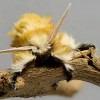 The southern flannel moth is an attractive small moth that is best-known because of its larva, the puss caterpillar, which is one of the most venomous caterpillars in the United States. This 12-page fact sheet was written by Donald W. Hall, and published by the UF Department of Entomology and Nematology, January 2013.
The southern flannel moth is an attractive small moth that is best-known because of its larva, the puss caterpillar, which is one of the most venomous caterpillars in the United States. This 12-page fact sheet was written by Donald W. Hall, and published by the UF Department of Entomology and Nematology, January 2013.
http://edis.ifas.ufl.edu/in976
Amaryllis Lesion Nematode, Pratylenchus hippeastri Inserra et al., 2006 (Nematoda: Tylenchida: Pratylenchidae) (EENY546/IN975)
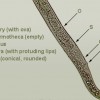 Amaryllis lesion nematode is an important nematode pest of amaryllis in Florida. It reduces plant vigor, flower yield, and bulb size. As the nematodes tunnel through the root, the damaged cells die and collapse, forming lesions on the exterior and the interior of the root tissue. This 4-page fact sheet was written by William T. Crow, and published by the UF Department of Entomology and Nematology, January 2013.
Amaryllis lesion nematode is an important nematode pest of amaryllis in Florida. It reduces plant vigor, flower yield, and bulb size. As the nematodes tunnel through the root, the damaged cells die and collapse, forming lesions on the exterior and the interior of the root tissue. This 4-page fact sheet was written by William T. Crow, and published by the UF Department of Entomology and Nematology, January 2013.
http://edis.ifas.ufl.edu/in975
Causes and Management of Insect and Mite Resistance in Strawberry Production (ENY841/IN713)
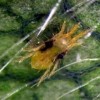 Episodes of pest resistance to popular pesticides can cause yield losses, reduction of fruit quality, added control costs, environmental degradation, and emotional stress among farmers. These consequences can be alleviated if resistance management is practiced throughout the strawberry industry. If they minimize pesticide application by depending more on biological and cultural pest control measures, and take care not to expose pest populations to pesticides with identical modes of action, growers can avoid causing pesticide resistance. This 8-page fact sheet was written by James F. Price and Curtis Nagle, and published by the UF Department of Entomology and Nematology, November 2012.
Episodes of pest resistance to popular pesticides can cause yield losses, reduction of fruit quality, added control costs, environmental degradation, and emotional stress among farmers. These consequences can be alleviated if resistance management is practiced throughout the strawberry industry. If they minimize pesticide application by depending more on biological and cultural pest control measures, and take care not to expose pest populations to pesticides with identical modes of action, growers can avoid causing pesticide resistance. This 8-page fact sheet was written by James F. Price and Curtis Nagle, and published by the UF Department of Entomology and Nematology, November 2012.
http://edis.ifas.ufl.edu/in713
Biology and Control of Sorghum-almum in Sugarcane (SSAGR369/SC098)
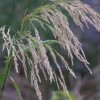 Sorghum-almum is a weak, perennial rhizomatous grass. Leaves of seedlings are rolled in a bud with a fringed membranous ligule. Seedlings often resemble corn seedlings when small. Stems of mature plants are stout and erect, reaching up to 14 feet tall. Leaf blades are flat and sandpapery. Sorghum-almum is commonly found in the southern part of Florida in sugarcane fields and along ditches, canals, and roadsides. This 3-page fact sheet was written by Dennis Calvin Odero, Ron Rice, and Les Baucum , and published by the UF Department of Agronomy, January 2013.
Sorghum-almum is a weak, perennial rhizomatous grass. Leaves of seedlings are rolled in a bud with a fringed membranous ligule. Seedlings often resemble corn seedlings when small. Stems of mature plants are stout and erect, reaching up to 14 feet tall. Leaf blades are flat and sandpapery. Sorghum-almum is commonly found in the southern part of Florida in sugarcane fields and along ditches, canals, and roadsides. This 3-page fact sheet was written by Dennis Calvin Odero, Ron Rice, and Les Baucum , and published by the UF Department of Agronomy, January 2013.
http://edis.ifas.ufl.edu/sc098
Biology and Control of Horse Purslane and Common Purslane in Sugarcane (SSAGR368/SC097)
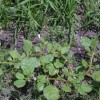 Horse purslane and common purslane are broadleaf weeds associated with sugarcane fields in muck (organic) and mineral soils of South Florida. Growers often confuse these two weed species with each other. However, these two species have distinct phylogenetic (evolutionary) and morphological differences. This 4-page fact sheet was written by Dennis Calvin Odero, Ron Rice, and Les Baucum, and published by the UF Department of Agronomy, January 2013.
Horse purslane and common purslane are broadleaf weeds associated with sugarcane fields in muck (organic) and mineral soils of South Florida. Growers often confuse these two weed species with each other. However, these two species have distinct phylogenetic (evolutionary) and morphological differences. This 4-page fact sheet was written by Dennis Calvin Odero, Ron Rice, and Les Baucum, and published by the UF Department of Agronomy, January 2013.
http://edis.ifas.ufl.edu/sc097
Biology and Control of Goosegrass in Sugarcane (SSAGR367/SC096)
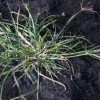 Goosegrass is an annual plant that produces a prostrate, mat-like rosette with flattened stems radiating from a central point. It is often described as looking like someone has stepped in the middle of the plant, flattening it out. Because of the whitish to translucent color of the leaf sheath margins, goosegrass usually appears white to silver; this is why it is known as white or silver crabgrass. Goosegrass is found year-round in southern Florida and is commonly associated with newly planted and stubble (ratoon) sugarcane fields. This 3-page fact sheet was written by Dennis Calvin Odero, Ron Rice, and Les Baucum, and published by the UF Department of Agronomy, January 2013.
Goosegrass is an annual plant that produces a prostrate, mat-like rosette with flattened stems radiating from a central point. It is often described as looking like someone has stepped in the middle of the plant, flattening it out. Because of the whitish to translucent color of the leaf sheath margins, goosegrass usually appears white to silver; this is why it is known as white or silver crabgrass. Goosegrass is found year-round in southern Florida and is commonly associated with newly planted and stubble (ratoon) sugarcane fields. This 3-page fact sheet was written by Dennis Calvin Odero, Ron Rice, and Les Baucum, and published by the UF Department of Agronomy, January 2013.
http://edis.ifas.ufl.edu/sc096
Biology and Control of Coast Cockspur in Sugarcane (SSAGR366/SC095)
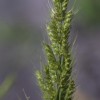 Coast cockspur is a relative of barnyardgrass that is native to North America. In South Florida, coast cockspur typically begins to infest sugarcane during the onset of rainfall in late spring. This 2-page fact sheet was written by Dennis Calvin Odero, Ron Rice, and Les Baucum, and published by the UF Department of Agronomy, January 2013.
Coast cockspur is a relative of barnyardgrass that is native to North America. In South Florida, coast cockspur typically begins to infest sugarcane during the onset of rainfall in late spring. This 2-page fact sheet was written by Dennis Calvin Odero, Ron Rice, and Les Baucum, and published by the UF Department of Agronomy, January 2013.
http://edis.ifas.ufl.edu/sc095
Spiral Nematode, Helicotylenchus pseudorobustus (Steiner, 1941) Golden, 1956 (Nematoda: Tylenchida: Hoplolaimidae) (EENY544/IN973)
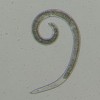 Spiral nematodes of the genus Helicotylenchus are among the most ubiquitous plant-parasitic nematodes worldwide. Helicotylenchus pseudorobustus is a species common in Florida and the southeastern United States and is frequently found associated with turfgrasses and other grass hosts in the region. On most plants, it is not considered particularly damaging, but recent research has shown that this species suppresses growth of certain turfgrass hosts. Seashore paspalum, a turfgrass used in tropical and subtropical regions, is particularly susceptible to infestation. This 4-page fact sheet was written by William T. Crow, and published by the UF Department of Entomology and Nematology, January 2013.
Spiral nematodes of the genus Helicotylenchus are among the most ubiquitous plant-parasitic nematodes worldwide. Helicotylenchus pseudorobustus is a species common in Florida and the southeastern United States and is frequently found associated with turfgrasses and other grass hosts in the region. On most plants, it is not considered particularly damaging, but recent research has shown that this species suppresses growth of certain turfgrass hosts. Seashore paspalum, a turfgrass used in tropical and subtropical regions, is particularly susceptible to infestation. This 4-page fact sheet was written by William T. Crow, and published by the UF Department of Entomology and Nematology, January 2013.
http://edis.ifas.ufl.edu/in973
A mosquito Psorophora ciliata (Fabricius) (Insecta: Diptera: Culicidae) (EENY540/IN967)
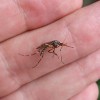 Psorophora ciliata (Fabricius) is a large mosquito that has developed an outsized reputation because of its relatively intimidating heft and persistent biting behavior, including anecdotal historical accounts of its legendary aggressiveness and ‘frightening appearance’. This 6-page fact sheet was written by Ephraim V. Ragasa and Phillip E. Kaufman, and published by the UF Department of Entomology and Nematology, October 2012.
Psorophora ciliata (Fabricius) is a large mosquito that has developed an outsized reputation because of its relatively intimidating heft and persistent biting behavior, including anecdotal historical accounts of its legendary aggressiveness and ‘frightening appearance’. This 6-page fact sheet was written by Ephraim V. Ragasa and Phillip E. Kaufman, and published by the UF Department of Entomology and Nematology, October 2012.
http://edis.ifas.ufl.edu/in967
A Colonial tentweb orbweaver Cyrtophora citricola (EENY535/IN966)
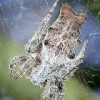 Few species of spiders can be considered truly social, but a greater number of species, particularly web-building spiders, live in close proximity to one another. One species which has become highly successful through a lifestyle of colonial aggregation is the orbweaver Cyrtophora citricola Forskål. This 6-page fact sheet was written by Lionel A. Stange, and published by the UF Department of Entomology and Nematology, October 2012.
Few species of spiders can be considered truly social, but a greater number of species, particularly web-building spiders, live in close proximity to one another. One species which has become highly successful through a lifestyle of colonial aggregation is the orbweaver Cyrtophora citricola Forskål. This 6-page fact sheet was written by Lionel A. Stange, and published by the UF Department of Entomology and Nematology, October 2012.
http://edis.ifas.ufl.edu/in966
Pesticide Safety Around Animals (ENY272/IG128)
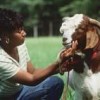 In general, infested animals are unhealthy and cannot be managed efficiently, so pesticides are commonly used to protect animals from pests. The successful control of pests requires careful mixing and application of recommended pesticides according to label directions. Besides ensuring the control of pests, applying pesticides at the recommended rate is necessary to prevent injury to the animal. This 5-page fact sheet was written by P. E. Kaufman and E. N. I. Weeks, and published by the UF Department of Entomology and Nematology, October 2012.
In general, infested animals are unhealthy and cannot be managed efficiently, so pesticides are commonly used to protect animals from pests. The successful control of pests requires careful mixing and application of recommended pesticides according to label directions. Besides ensuring the control of pests, applying pesticides at the recommended rate is necessary to prevent injury to the animal. This 5-page fact sheet was written by P. E. Kaufman and E. N. I. Weeks, and published by the UF Department of Entomology and Nematology, October 2012.
http://edis.ifas.ufl.edu/ig128
Deep Problems in Shallow Lakes: Why Controlling Phosphorus Inputs May Not Restore Water Quality (SGEF198/SG128)
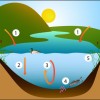 Florida’s thousands of lakes are shallower than most people realize, and some unique properties of shallow lakes make them challenging to restore if they have been degraded by nutrients or other pollutants.This 4-page fact sheet examines how water managers track nutrients as they cycle through Florida’s lakes. Written by Karl Havens, and published by the UF Department of Sea Grant, January 2013.
Florida’s thousands of lakes are shallower than most people realize, and some unique properties of shallow lakes make them challenging to restore if they have been degraded by nutrients or other pollutants.This 4-page fact sheet examines how water managers track nutrients as they cycle through Florida’s lakes. Written by Karl Havens, and published by the UF Department of Sea Grant, January 2013.
http://edis.ifas.ufl.edu/sg128